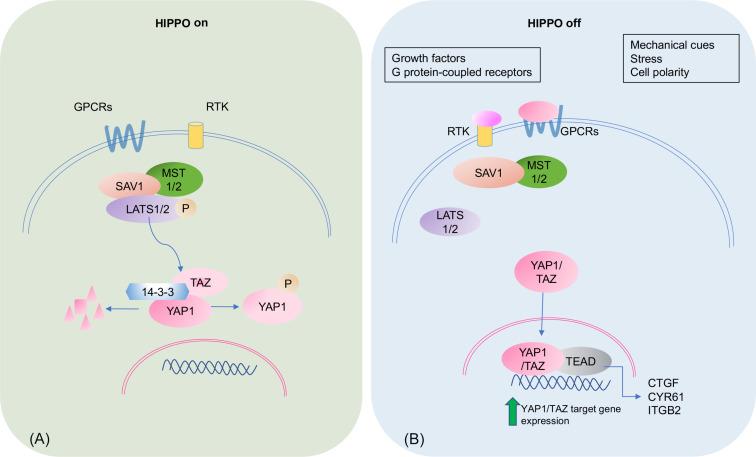Physical Address
304 North Cardinal St.
Dorchester Center, MA 02124
The authors declare no conflict of interest.
The Hippo pathway was first described in Drosophila melanogaster and core proteins in the kinase cascade and coactivators are highly conserved in mammalian cells. The Hippo pathway consists of regulatory kinases that modulate transcriptional output including STE-20 like protein kinase 1 and 2 (MST1/2; homolog of Drosophila Hippo), Salvador family WW domain-containing protein 1 (SAV1; homolog of Drosophila Salvador homolog 1), large tumor suppressor 1 and 2 (LATS1/2; homologs of Drosophila Warts), MOB kinase activator 1A/B (MOB1A/B; homolog of Drosophila MATS), and mitogen-activated protein kinase kinase kinase kinase 4 (MAP4K4; homolog of Drosophila Misshapen). The two conserved coactivators, Yes-associated protein1 (YAP1) and transcriptional coactivator with PDZ-binding motif (TAZ), are homologs of Drosophila Yorkie (Yki). YAP1/TAZ is essential for TEA domain family member (TEAD) 1–4 transcriptional activation. Hippo signaling cascade is initiated when of MST1/2 and SAV1 phosphorylate and activate LATS1/2. This leads to the phosphorylation of YAP1 and/or its binding of 14-3-3 to TAZ, resulting in its sequestration to the cytoplasm and degradation. YAP1/TAZ are essential coactivators for TEAD family of transcription factors. In growth-permissive conditions, Hippo pathway is inhibited leading to the stabilization of YAP1/TAZ and activation of TEAD target genes that suppress apoptosis and promote cell proliferation. The activation and inhibition of YAP1/TAZ are mainly regulated by Hippo kinase cascade. However, the upstream kinases are integrated into a diverse number of environmental cues that regulate Hippo kinase cascade. Other pathways have been identified recently including components of tight junctions, adherent junctions, or apical-basal polarity. Below, the regulation of YAP1/TAZ by other pathways will be discussed, including mechanical cues, contact inhibition, stress, cell polarity, G-protein-coupled receptors (GPCRs), and epidermal growth factor ( Fig. 5.1 ).

Mechanotransduction systems are important signals for growth and cell proliferation. Every cell responds to mechanical signals from the environment. Changes in elasticity/stiffness of the extracellular matrix (ECM) or force of traction/compression from adjacent cells regulates YAP1/TAZ subcellular localization. These mechanical forces are continuously transmitted among cell-cell or cell-ECM contact, which allows the rapid adjustment of cell stiffness via actomycin cytoskeleton contraction, cell shape and organ size control. Regulation of YAP1/TAZ via mechanical cues can be independent of Hippo signaling relying on Rho-GTPases and F-actin or the focal adhesion kinase (FAK)-Src-phosphatidylinositol 4,5-bisphosphate 3-kinase (PI3K) pathway. However, a cell detachment mediated apoptosis termed anoikis is dependent on Hippo signaling. Through cytoskeleton reorganization, detachment leads to increase in LATS1/2 kinase and inactivation of YAP1 and TAZ. Anoikis is thought to be the major pathway by which differentiated intestine epithelial cells (IECs) undergo apoptotic cell death as they are sloughed off when the cell reaches the villi tips. Currently, it is not clear what role Hippo signaling plays in normal physiological regulation of anoikis in the intestine; however, in cancer cells, knockdown of YAP1 and TAZ restores anoikis-mediated cell death. In addition, cell polarity also regulates Hippo signaling. Crumbs is a mechanosensor that regulates cell polarity and was first discovered in D. melanogaster. Increase in Crumbs protein leads to increase in the apical surface, and YAP1/TAZ is phosphorylated via canonical Crumbs/CRB-Hippo/MST-Warts/LATS kinase cascade, which is initiated by integrins and Src family kinases.
Hippo pathway is highly active via cell-cell contact and is essential for contact growth inhibition. High cell density activates LATS kinase and leads to YAP1 inactivation, whereas low cell density inactivates LATS and results in YAP1 activation. Contact growth inhibition can be reversed via YAP1 overexpression, providing further evidence for the importance of Hippo signaling in regulating tissue and cell proliferation.
Several stress signals regulate YAP1/TAZ activity, including chemical, heat, hypoxia, energy stress, endoplasmic reticulum (ER) stress, and oxidative stress. Heat shock or high concentration of sodium arsenite, a chemical stressor to induce heat shock proteins, activates MST1/2 and results in YAP1/TAZ cytoplasm localization. Hypoxia, on the other hand, modulates Hippo signaling through E3 ubiquitin ligase SIAH2-mediated degradation of LATS2, resulting in the activation of YAP1/TAZ to promote tumor cell proliferation and growth. Glucose deprivation rapidly activates LATS1/2 to phosphorylate YAP1/TAZ. In addition, low cellular glucose levels can activate AMP-activated protein kinase (AMPK), which can directly phosphorylate YAP1 and inhibit YAP1/TAZ/TEAD target gene transcription. Studies in Drosophila show that mTORC1 and mTORC2 induces Yki nuclear localization, while decreased mTORC1/2 prevents Yki target gene activation. In eukaryotic cells, the endoplasmic reticulum (ER) is the primary subcellular organelle that is important for protein folding, lipid and sterol biosynthesis, and calcium storage. ER stress occurs when unfolded or misfolded proteins accumulate in the ER lumen. ER stress activates unfolded protein response (UPR) to reduce unfolded/misfolded protein through ER membrane expansion, protein synthesis reduction, and quality control. YAP1 is important for ER expansion and UPR activity via PKR-like ER kinase (PERK)—eukaryotic initiation factor 2α (eIF2α) axis to reduce ER stress. Oxidative stress is associated with increased production of reactive oxygen species. Forkhead box protein O1 (FoxO1) regulates antioxidant genes, including catalase and manganese superoxide dismutase (MnSOD), to exert protective effect against oxidative stress. YAP1 forms a complex with FoxO1 on the promoters of the MnSOD antioxidant genes and stimulates their transcription, while inactivation of YAP1 suppresses FoxO1 activity and decreases antioxidant gene expression, implicating the role of YAP1 in modulating the FoxO1-mediated antioxidant response.
Become a Clinical Tree membership for Full access and enjoy Unlimited articles
If you are a member. Log in here